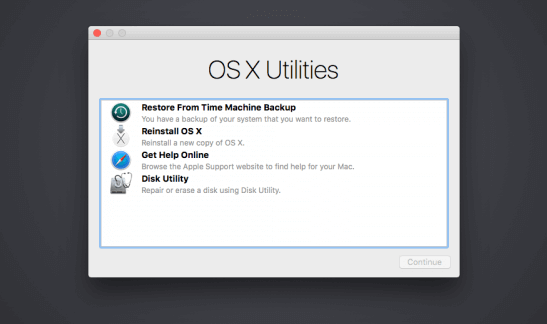

- Mac os create recovery partition mac os x#
- Mac os create recovery partition install#
- Mac os create recovery partition update#
- Mac os create recovery partition manual#
- Mac os create recovery partition full#
Mac os create recovery partition mac os x#
Why and when should we create a Mac OS X recovery USB drive?

Your Mac can be booted from recovery partition by holding the “CMD+R” keys together during boot up. Every Mac running OS X Lion and later has a small (650MB) hidden recovery partition called Recovery HD located on your Mac’s internal hard drive which is reserved for common utilities such as Time Machine Backup,Terminal utility, Disk Utility, Hardware Diagnostic tool and other built in set of utilities. Immediate two-step High Sierra Installer HFS+-APFS is the best way forward for all of our Macs, 2017 new and 2011 old.This article will help you create a Mac OS X or macOS recovery USB drive to use in case of disaster or no boot from internal hard drive.
Mac os create recovery partition update#
After waiting a month, AppleCare advised to update more directly, first from Sierra to High Sierra HFS+ and then immediately to APFS. Also, we found that our gradual graduation of Macs was not necessary. If it's any encouragement, iCloud saved data is not any concern. Your HFS+ recovery of Recovery should now be complete. YOU MUST manually configure High Sierra to reset Boot Disk to HFS+. We used our backup sticks to Restore personal data not stored in iCloud following the Repair-Erase.Įrase your boot partition having initial problems with APFS. Fortunately we had sticks to copy our files to before the initial APFS install.
Mac os create recovery partition manual#
Use a good old-fashioned manual folders-with-files backup to any external media. However, sadly our Time Capsule was lost cause after failed APFS update, because even though Capsule Disk Recovery was not found in APFS macOS, it had been "touched" by the APFS installer, rendering it useless to HFS and APFS. Apple Engineers will have that Time Machine Recovery sorted out soon. For one thing, you will need another backup than Time Machine if you use Airport Extreme Time Capsule, as old HFS backups are not discoverable (wrong partition association) for APFS Time Machine. I have been told by those who know that if I insist on pushing (forcing) APFS straight onto systems having initial problems with APFS, that is fruitless.
Mac os create recovery partition install#
On the setup screen, do not install until you open and use Disk Utility to Repair and Erase your boot partition. Steve, reboot your Apple device holding down two keys, Command-R keys together - ⌘ -R at the same time. The installer, do you mean the Mac App Store? That way it won't self delete after you use it. Once the installer downloads to your Applications folder, quit the installer, and make a copy of it or move it out of your Applications folder. The old MacBook's HD is the standard 256 GB SSD, it's the early 2016 model.Īgain with "reinstalling the macOS overtop of an existing macOS partition," does this mean it keep the old files and docs, and only add the Recovery Partition to the Mac HD? My internet subscription is only 20Mbps tops, in real use it's less than that. I don't know how fast your Internet connection is, and I don't know the speed or type of your hard drives.įor me, on a Early 2015 12" Retina MacBook with a 500 GB SSD, reinstalling the macOS overtop of an existing macOS partition takes less than an hour. I saw the High Sierra during last WWDC keynote (via on-line), I think I'll better wait until it's released so I don't have to do it (reinstalling the macOS) twice. Wait, so all the files and docs will not be deleted?ĭoesn't reinstall the macOS mean erasing the HD and start again from beginning?
Mac os create recovery partition full#
Just to note, there probably won't be anymore point updates to Sierra before the release of High Sierra (Can't really speculate though), but many people download the latest full installers and run them over their existing partitions in lieu of using the App Store Software Update feature. No, it just reinstalls overtop of your existing partition.


 0 kommentar(er)
0 kommentar(er)
